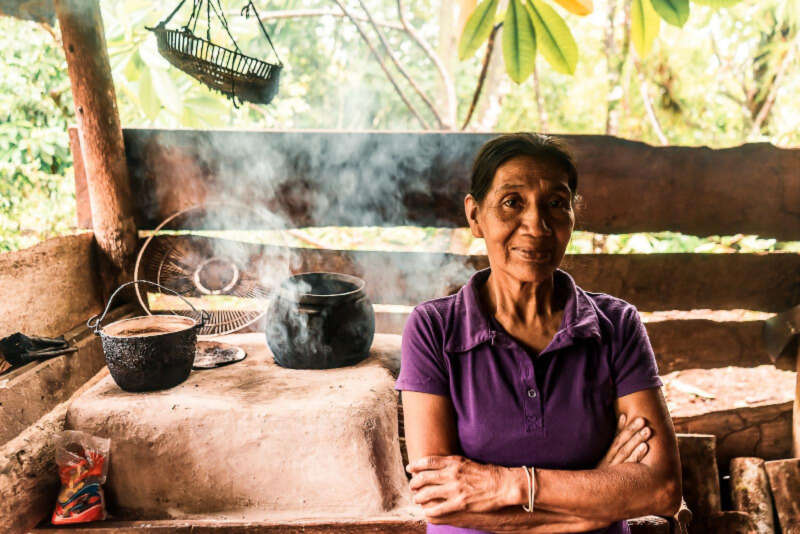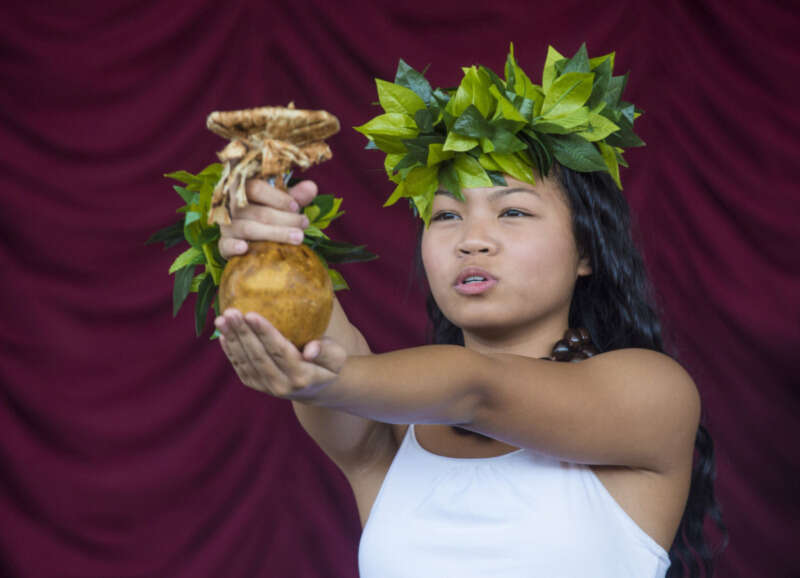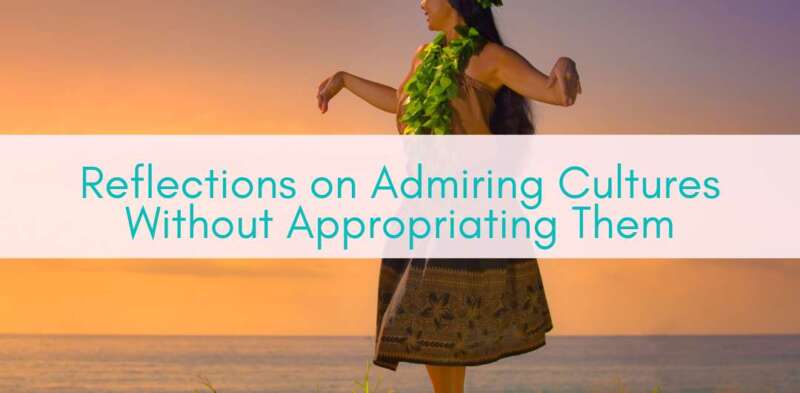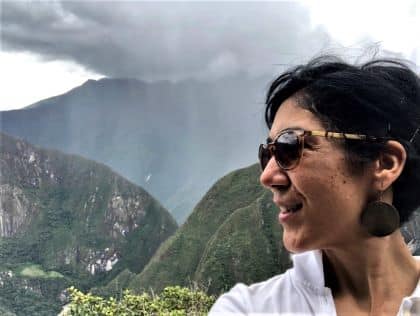Reflections on Admiring Cultures Without Appropriating Them
Many of us travel to soak up a different culture. Basking in the beauty of a people’s customs and traditions allows us a chance to experience a place more intimately.
Reflections on Admiring Cultures Without Appropriating Them
But what happens when instead of admiring and enjoying it, we end up partaking in cultural appropriation? Sometimes it is done unintentionally, and without realizing what we’re doing. That’s why awareness, questions, and reflection are crucial parts of our global trekking, especially to ones where our knowledge thereof is limited.
A Matter of Interpretation
As with much in life, the conversation often boils down to definition and interpretation. We all know there’s a difference between a text book/internet explanation and what we process said term to mean.
Urban dictionary defines cultural appropriation as:
“the act of taking customs, practices, or traditions from one culture (usually by a member of a dominant culture) to either mock or simplify the meaning or significance of that piece of culture.” Going a step further, they note [it is also] “taking/wearing something from another culture and appreciating it only when it is not on the body of a member of that culture.”
In this Very Well Mind article by social anxiety expert Arlin Cuncic, she shares thoughts on cultural appropriation. “[It] refers to the use of objects or elements of a non-dominant culture in a way that reinforces stereotypes or contributes to oppression and doesn’t respect their original meaning or give credit to their source. It also includes the unauthorized use of parts of their culture (their dress, dance, etc.) without permission.”
Both definitions are clear on one thing – ‘dominance’ being the operative word. This must be emphasized because historically, it has been Indigenous and African-rooted nations and their cultures that have been oppressed and abused.
It’s one thing to articulate the phrase with words, in an attempt to give it some color. But what does this ‘non-consensual borrowing’ look like? A few examples to consider:
- A non-Native American tribe member wearing a ceremonial headdress
- A non-Native Hawaiian engaging in hula at a lūʻau
- A non-Indigenous (i.e., non-Huetar Nation, non-Acjachemen, non Amah Mutsun) person burning white sage
- A non-Puerto Rican engaging in bomba dance without acknowledging the drummer(s) when entering & leaving the Batey (the space where we celebrate & connect with our African and Indigenous Taíno ancestors)
- Practicing yoga without acknowledging & respecting the Indian customs connected thereto
Deeper Diving Scenarios
In order to attempt to understand what cultural appropriation means, it’s imperative to consider the voices of persons directly impacted. Without their perspectives and valuable insights, the conversation becomes an invalid one.
Costa Rica

Engaging with [self-described] Brown Native American Writer and Visual Artist, Sulastri Mukti, a member of the Huetar Nation, we learn about their sacred relationship to the ancestral tradition of burning white sage.
“Ancestral rituals are being appropriated by rich kids, yoga teachers, hippies, influencers, and ‘woke’ yet racist millennials.”
“Acjachemen tribes, Mutsun tribes, and other indigenous groups grew up burning sage since they were little kids, in their Indigenous communities. Burning sage is an ancestral tradition passed on from one generation to another, practiced for thousands of years. It has been used as a source of food, ancestral medicine, and smudging to give an offering to Pachamama (Mother Earth) and a way to connect with our ancestors. When making an offering with white sage or any other kind of plant that has been used by Indigenous communities for centuries, there is a list of things that people should do before burning it, in order to preserve Indigenous culture and the medicinal value that sage provides.
It’s not just burning a little stick of white sage while you record a video of yourself feeling super ‘connected to Mother Earth.’ It doesn’t work like that and it’s not that simple.”
India

Hindu Human Rights Activist and Oxford University graduate, Rashmi Samant sheds perspectives on something that forms an integral part of many of our lives. Sharing in The Sunday Guardian article, she discusses the situation with India and the West.
“In a world where cultural appropriation is called out loudly and almost instantly cancelled, the ancient practice of Yoga has been internationally stripped of its Indian roots within Sanatana Dharma. Cultural appropriation is defined as ‘The unacknowledged or inappropriate adoption of the customs, practices, ideas…’ What is being done to Yoga is no less than that. It has been reduced to a form of a trendy set of exercises with no acknowledgment of its origins or respect for its customs. The West has monetised and taken advantage of the mindfulness of Yoga, meditation and re-packaged it within neo-colonial frameworks.”
Taking a look at another of India’s traditions brings us to Holi, the Hindu Festival of Colors celebrating the ‘beginning of the spring season,’ wherein participants paint themselves [and sometimes spray others] with colored powder or colored water. It also is considered an ‘opportunity to meet people and repair broken relationships.’ So, does this mean that non-Hindu person should not partake of the festivities?
No! Media’s Racial Justice Editor, Sonali Kolhatkar shares thoughts in her piece, How to Celebrate Holi Without Culturally Appropriating It.
- Education – ‘educate yourself about India’s celebrations of Holi and acknowledge that you are partaking in someone else’s culture’
- Images – when posting to social media, ‘label the event as Holi (not ‘color run’)’
- Language – use respectful descriptions of enjoyment of ‘being drenched in color, and the playful communion it engenders’
- Ethnic connection – ‘if you’re not Indian, don’t organize a Holi-related festival yourself—unless you’re collaborating with an Indian organizer or the local Indian–South Asian community in your city’
- Attire: ‘Don’t dress up as an Indian when you attend Holi-related events (unless your Indian friend has invited you to a traditional celebration and offered you an outfit or given you suggestions on what to wear). Don’t randomly stick bindis all over your face, don a “belly dancing” skirt, or adorn yourself with henna “tattoos” you ordered off Amazon
- Economic benefit – ‘especially, don’t try to make money off of it. Instead, consider raising money for immigrant communities or to support Indian-led projects in India.’
Hawai’i

Long known for being a tourist hot spot, the archipelago receives visitors excited to grab a piece of Hawai’i’s rich and varied cultures. This is a source of pain for Indigenous Researcher, Kilohana Haitsuka. She poignantly reflects on these sentiments in her opinion piece, From an unapologetic Hawaiian:
“Among the many customs associated with my upbringing as a Native Hawaiian, few were held with such sanctity as traditional Hawaiian dance. As a child, dancing to “Hanalei Moon” with my ʻohana’ was not just a family tradition, but a means of maintaining spiritual and genealogical expression.
Upon moving to the continental states, I was disappointed to witness a significant practice such as hula be treated as entertainment and depicted in culturally offensive ways.”
Again, here it’s about more than being politically correct. Haitsuka further elaborates, “Lūʻau performed by non-Hawaiian individuals is problematic for several sociopolitical and historical reasons. Hula, the primary form of dance featured at lūʻau, was once banned due to the influence of missionaries who thought it promoted heathen beliefs. Cultural practitioners created hula auana and hula kahiko to distinguish events from ordinary tourist shows, and to encourage “authentic” hula performances. Kahiko, the ancient dance, involves specific oli (chants) and dress code that are often absent in mainland lūʻau.”
Also noted in the article is the ‘sexualization’ of their culture: the “personified Western image of the Native woman. Her exotic allure, a fantasy created and exploited by the American-backed tourism industry. Haunani Kay-Trask refers to this exploitation as the prostitution of Native Hawaiian culture, which can be seen in ad campaigns that sexualize our culture by covering it in grass skirts and coconut bras. Exoticizing Hawaiʻi is problematic because it portrays native culture as a “Hawaiian” brand that can be consumed by individuals and corporations for social and economic benefit.”
In the article, published at the University of Portland’s The Beacon, Haitsuka recalls the scene at a Hawai’i Club lūʻau. “I watched as men with sharpie tattoos performed the haka, a Māori war dance, caricaturing the experiences of Maori people without attention to the cultural and historical context. I listened to laughs of my haole [non-native Hawaiian, especially a white person] peers as significant cultural practices were reduced to mere entertainment. The experience failed to honor the sacrifices of my ancestors who dedicated their lives to cultural revitalization.”
Noting that ‘when non-indigenous individuals, including those from Hawai’i, participate in lūʻau, they unwittingly participate in a long tradition of theft and denial. Haitsuka offers suggestions to avoid cultural appropriation.
- Learn to engage with other cultures beyond an aesthetic level
- Provide social and political context for traditions
- Representation: Who’s at the table? (ensure respectful and thoughtful engagement)
- Hula should not be something others partake in just because it is fun, and lūʻau should not be performed simply for entertainment
She ends with this reminder: “A famous Hawaiian proverb reads, “nana i ke kumu”: Look to the source. It is an insightful admonition to remember and respect the cultural roots of Hawaiʻi and all of Polynesia.”
Borikén
As a U.S. territory, this tiny Caribbean archipelago is also a popular tourist destination. Becoming familiar with its relationship to the United States will help visitors understand we’re not ‘another state.’ Many are familiar with our colonizer label, Puerto Rico.
One step people can take to self-educate, is by learning some of our history. Borikén is our Indigenous name, given by our Taíno (an Arawak people). It means, ‘Land of the Valiant and Noble Lord.’ And while many may be familiar with Borikén’s original colonial history (the Spanish arrived in 1493), much of our unique flavor originates with our African and Indigenous heritages. From these we inherited our beloved bomba, one of our traditional folk genres (with West African roots), as well as some of the culinary traditions (think: root vegetables, like yuca) retained from our Taíno ancestors.
Boricuas [and others who call themselves Puerto Ricans] are a flavorful people, we enjoy color, literally and figuratively. We invite folks to partake in all we offer, without culturally appropriating any of it.
Ways to respect our culture:
- When participating in Bomba, always acknowledge the drummer(s) upon entering & exiting the Batey
- Learn about why many femmes who identify as AfroBoricua, wear headwrap (can be controversial for white women to sport)
- Visit Indigenous Caves and archeological sites respectfully (speak in lowered voices, do not take rocks or other items, avoid performing rituals if you do not have ancestral ties to Borikén)
- Speak a few words in Spanish to locals (yes, it’s our colonizer’s tongue, but it still shows respect)
- Avoid touting how it’s ‘just like Florida or California’ (or any other state)
- Inform yourself about the political and economic landscape – tread delicately if these conversations arise, being mindful that many here are adamantly pro-Independence and are offended by suggestions that we become #51
Halloween
For those who celebrate the popular All Hallow’s Eve tradition, cultural appropriation touches another angle. Images on social media of people happily parading in their Halloween attire might seem like loads of fun, but it’s imperative for folks (and parents, in the case of children) to exercise awareness.
A look at this NPR article outlines what we’re getting at on the issue of that famed October festivity. Considering the ‘Mexican look,’ ‘Arab Sheik outfit,’ and ‘Native American ensemble,’ as a few examples, the degradation becomes clearer. As Henu Josephine Tarrant, artist and performer of the Ho-Chunk, Hopi, and Rappahannock tribes shares, “It goes deeper than what you’re dressed like. When you really look at it and you really study these tropes and stereotypes and what they mean and how they affect us as Native people, you know they’re all rooted in a historically violent past.”
Noting that the style of clothing depicts a violent era in the 19th century is also significant.
Tarrant further adds: “In real life during this time period, during all of these Dakota wars and these other wars and these removal acts, starvation, famine and tuberculosis, smallpox — I mean so many sicknesses and violence were attached to that time period.”
For another consideration, we look at darkening one’s skin to ‘pose as a Black or Brown person.’ This is dehumanizing as it fails to acknowledge the racist implications behind the same. This Do Something piece elaborates thereto:
“Wearing blackface is hurtful because it was — and is — used to create a caricature of Black Americans, exaggerating the Black form and reinforcing racist perceptions. Historically it has been used to perpetuate the fallacy that Black people are inferior to white people. Starting in the 1800s, white American actors performing in minstrel shows would rub their faces with shoe polish or grease paint to impersonate and act out racist stereotypes of Black people.”
Another one to reflect on is the geisha. This Stylist article shares insights: “In Japan, geisha culture is one of tradition and respect. [They] are part of Japanese culture and history. Identifiable by their white faces, bright red lips, and elaborate hairstyles, geishas are treated like celebrities in their own country. Unfortunately, in the West geishas (a performing artist) have long been misunderstood as high-class prostitutes – but that’s not the case. Geishas perform publicly and at large events (attended by men and women).”
When it comes to children, we turn again to NPR’s article. Jess Lifshitz, a fifth-grade Illinois teacher is proactively helping parents and students become a part of the solution. Sending a letter to her students’ homes prior to Halloween, she reminds them why ‘dressing in a caricature of someone else’s identity is hurtful.’
“While students might choose to dress as a famous person or character whose identity is different than their own, please reinforce the importance of not darkening skin or using makeup to change a child’s skin color to match the person who they are dressing up to be. Students are often unaware of the long history these traditions have of causing harm and need our help in understanding why it can be hurtful and problematic.”
Appreciation versus Appropriation
Understanding a culture means going deeper than what’s on the surface. It factors in things like learning a language, preparing a meal from a recipe, digging into the history, talking to people and asking respectful questions. All of this is part of showing appreciation. So how to ensure we’re doing just that and not appropriating a culture? In their blog post, Cultural Appreciation vs. Cultural Appropriation: Why it Matters, Greenheart Club offers this.
“Appreciation seeks to understand and learn about another culture to broaden one’s perspective and cross-culturally connect. Appropriation takes one aspect of [someone else’s] culture for personal interest. [It] could be purchasing a piece of jewelry or clothing of important cultural significance to that culture, but simply using it as a fashion statement. It could be taking a photo of a ritual ceremony simply for the sake of getting as many likes on Facebook as possible.”
Sonali Kolhatkar gives a simple, yet impactful message on how to ensure one engages in cultural appreciation and not appropriation: “My culture is not a costume.”
Lola is a poet, travel blogger, translator, and cultural storyteller. Completing her 200-hour Yoga Teacher Training in 2016 helped her begin the healing process of a painful divorce. Fiercely proud of her Indigenous and African roots, much of Lola’s work celebrates vibrant female voices. Outside of global trekking and crafting stories, she counts tango as another passion. In late 2021, Lola returned home to her precious Borikén where she is working (with her friend and business partner, Yuma) to bring collective healing through yoga, meditation, and the Afro-Boricua bomba folk tradition.
Topics
Subscribe
Subscribe for news, updates, giveaways, and more!
JOIN GIRLS WHO TRAVEL
Join our inclusive community
of tens of thousands of women who
share your passion for travel in our
Girls Who Travel Facebook group!









